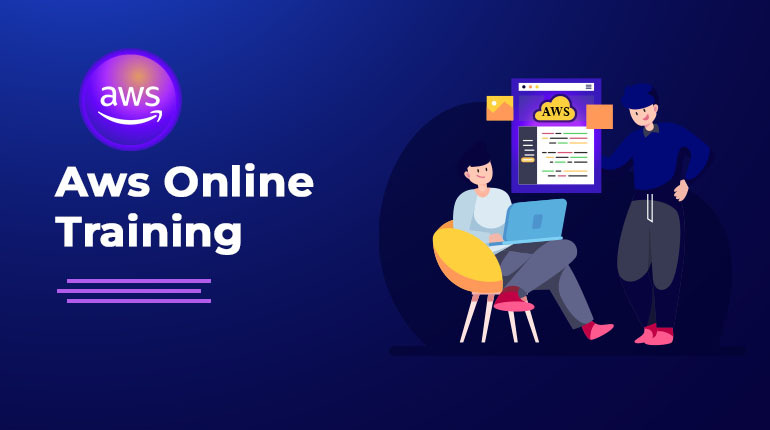
Aws online Training
AWS Course Overview
You will be able to apply crucial AWS services like computing, storage, and database to various use cases by taking this online course from AWS. Our knowledgeable faculty is always glad to answer your questions and provide the greatest knowledge currently being used in the field. This training course is jam-packed with practical exercises and examples. You will become familiar with concepts like AWS security, AWS console, Lambda, EC2, DyanmoDB, Cloudfront, and a lot more.
Key Features
- Fundamentals of AWS Services
- Understanding AWS architecture
- Core concepts of AWS framework
- Get AWS certification
- Provide you with important AWS interview questions
- Guidance in building AWS resume
- Schedule your timings according to your convenience
- One on One session
AWS online training is available for those looking to advance their technical knowledge and get an AWS professional certification. A person's professional talents can gain value from the qualification as well.
AWS Live Class Curriculum
- Lesson 2.1: AWS Overview
- 2.2 Introduction to AWS
- 2.3 Core AWS Services
- 2.4 Accessing AWS Services
- 2.5 Assisted Practice: Set up the AWS Command Line Interface
- 2.6 AWS SDKs
- 2.7 Assisted Practice: Set Up AWS SDK
- Create S3 Bucket via Console and AWS CLI
- Lesson 03: Amazon Elastic Compute Cloud
- 3.1 Section Introduction
- 3.2 Amazon Elastic Cloud Computing
- 3.3 Amazon Machine Image
- 3.4 Amazon EC2 instance IP addressing
- 3.5 EC2 Instance Metadata
- 3.6 Assisted Practice: Create a Linux Based EC2 Instance
- 3.7 Assisted Practice: Create a Windows Based EC2 Instance
- 3.8 Assisted Practice: Launch an EC2 Linux Instance and install a webserver using user data
- 3.9 Assisted Practice: EC2 instance Connect
- 3.10 Assisted Practice: Create Custom AMI
- 3.11 Assisted Practice: Launch an Instance Using a Custom AMI
- 3.12 Introduction to Amazon EBS
- 3.13 EBS Snapshot
- 3.14 Assisted Practice: Create and Attach an EBS Volume to a Linux Instance
- 3.15 Assisted Practice: Create a Snapshot of an Existing EBS Instance
- 3.16 Elastic File System
- 3.17 Difference between EFS and EBS
- 3.18 Auto Scaling
- 3.19 Amazon Elastic Load Balancer
- 3.20 Types of Amazon Load Balancers
- 3.21 Assisted Practice: Set Up an Autoscaled Environment
- Host your Website Inside your EC2 Instance
- Lesson 04: Amazon Storage Services
- 4.1 Section Introduction
- 4.2 Introduction to Amazon S3
- 4.3 Assisted Practice: Creating an S3 bucket
- 4.4 Version Control in Amazon S3
- 4.5 Assisted Practice: Configure an S3 Bucket for versioning
- 4.6 Static Web Hosting
- 4.7 Amazon S3 Policies
- 4.8 Assisted Practice: Configure an S3 Bucket for Static Website Hosting
- 4.9 Amazon S3 Storage Classes
- 4.10 Amazon S3 pricing tiers
- 4.11 S3 Select and S3 Glacier Select
- 4.12 Sharing an S3 bucket between multiple accounts
- 4.13 Backup and DataSync
- 4.14 Amazon CloudFront
- 4.15 Assisted Practice: Configure a new CloudFront distribution with an S3 bucket
- Hosting a Static Website on Amazon S3
- Lesson 05: Databases on AWS
- 5.1 Section Introduction
- 5.2 Introduction to Databases
- 5.3 Amazon RDS
- 5.4 Assisted Practice: Create an RDS Database Instance
- 5.5 Amazon DynamoDB
- 5.6 Assisted Practice: Create a Table Using the DynamoDB Console
- 5.7 DynamoDB concepts
- 5.8 Amazon ElastiCache
- Storing Application Data in MySQL DB using Amazon RDS
- Lesson 06: Amazon Virtual Private Cloud
- Lesson 07: Amazon Route53
- Lesson 08: IAM and security on AWS
- Lesson 2.1: AWS Overview
AWS Certification Training FAQ’s:
AWS (Amazon Web Services) is a comprehensive, evolving cloud computing platform provided by Amazon that includes a mixture of infrastructure as a service (IaaS), platform as a service (PaaS) and packaged software as a service (SaaS).
Some of the services offered by AWS include Amazon Simple Storage Service (S3), Amazon Elastic Compute Cloud (EC2), Amazon DynamoDB, and Amazon Route 53.
Both AWS and Azure are popular cloud platforms, but they have some key differences. AWS is more comprehensive and offers more services, while Azure is geared towards developers and offers a more intuitive interface.
The most popular use of AWS is for storage, with over 20% of users taking advantage of its S3 (Simple Storage Service). This is followed by compute (EC2 - Elastic Compute Cloud), which is used by over 10% of users. Other popular services include Glacier (for long-term data archival) and CloudFormation (for Infrastructure-as-Code).
Some common uses for AWS include web and application hosting, storage, databases, analytics, machine learning, and artificial intelligence.
AWS (Amazon Web Services) is a comprehensive, evolving cloud computing platform provided by Amazon that can be used for a variety of projects. One way to use AWS is to create an Amazon Machine Image (AMI), which is a template that can be used to launch an instance, or virtual machine, in the cloud.
